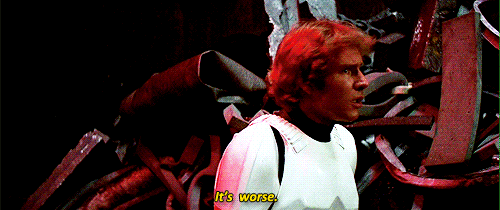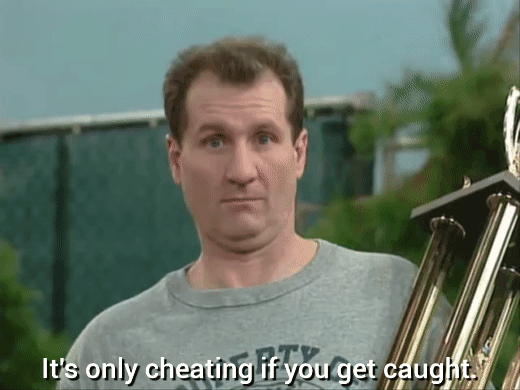If you missed last week, I started a series talking about different ways that die rolls can go wrong, and some methods a GM can use to work around it to keep the story moving. Last week covered a lot of the base work and talked about ways to handle it when the dice get a higher success than you anticipated, so I recommend to check it out here first.
Today, we’re going to be talking about the exact opposite scenario: you have a story-critical part that requires a die roll that the players should be able to make, but the dice give them a failed result. This problem has plagued GMs across games for years, and it’s difficult to come up with a solution that is able to still move the story forward without cheapening or disregarding the die results. Failure has to have consequences, otherwise it loses its bite, the players feel like the game world has no risk and they have no impact or autonomy, that the story is happening around them rather than involving them. That will very quickly get boring, and you’ll end up with players just waiting around until they can feel relevant again. At the same time, the story still has to progress, and having everything brought to a standstill because of bad dice rolls is also boring.

Don’t despair though, because it doesn’t have to be this way. If executed gracefully, failure can be just as if not more interesting than success. Stories, after all, are driven by conflict, and failures can easily create all sorts of conflict.
One of the first points to consider as we go through these examples is, how bad is the failure? Is the result just short by a few points, or is this a Rule of One scenario? Certain solutions work better for one than the other, some can be adjusted to work for both. Sometimes you’ve got multiple aspects going on, like multiple possible methods of solving a situation (which is one of the ways to try and avoid this situation in the first place), and all of them have failed to varying degrees. You’ll need to adjust the results accordingly, and leave yourself some space where things could get worse (at least until you get an actual Rule of One).

As alluded to above, one of the possible ways to save yourself from the game being halted by a bad die roll is to have multiple die rolls possible. This can be in the form of allowing players to try their roll again, having multiple different methods to try, or having multiple characters try. Before you even play a game and just look through the rule book, you’ll notice there are several Skills that could easily have some overlap in certain situations. Each Skill has its particular main application, but a lot of the time there are secondary ways you could use it that might overlap with other Skills. Say for example your players have found themselves down in an abandoned mine, the entrance they took has collapsed in, but there’s an old broken lift that they could repair to raise themselves out. The group’s Brassman steps forward, attempts to roll Mechanic to get the engine driving the elevator working, but completely flubs the roll. If someone else in the party has Mechanic, you might have them take a crack at it, or you might have the two work together to try the roll again. If the roll was a near miss, you might say they get into it and find there’s a part missing that prevents the repair from being completed, and they’ll have to try a different Skill like Metalworking to fabricate a new one before they can try again, or go looking through the supplies left down here to see if there’s a spare. They might also use a different Skill like Field Engineering to try and come up with a solution to get the lift working without the engine. Or you could always have them brute force it and try Climbing rolls to just climb up the ropes of the lift without relying on the lift itself moving. By the law of averages, when you’re getting random results like you will with dice, if you make enough tries, one of them eventually has to work. From a story perspective, trying and failing until you come up with a solution can be a great driver to build up tension and make the eventual success feel all the more sweet.
One that was mentioned last week as a solution to a success that goes too high is the unforeseen complication, the classic “Yes, but…” situation where the players are still able to achieve the result they want, but not in the way they intended. This is one that will typically work better for a near miss, and often times with our published material, we write suggestions for this directly in. Unlike with a runaway success, here you can feel free to make the complication much more negative than positive. You’re allowing the action to go through so the story can progress, but the result did indicate a failure, so there have to be negative consequences for that. For our example, let’s say your group is doing a dodge and your Byron performs a tap on the hydraulic input lines to gain access to the security doors. If they get a failure result on setting up the tap, rather than just being unsuccessful, you could allow them in, but the tap is causing hydraulic oil to leak, so they’ve only got a few minutes before the system loses enough pressure to stop working and set off an alarm that alerts the guards. Now a job that should have been a lot easier has a time crunch, and everyone has a higher difficulty because they have to work fast. The story progresses despite the failure, but now the stakes are higher and you’ve instantly added more tension and drama to the scenario.

Let’s look further to the extremes and how to deal with a situation where your players have not only failed, but have failed spectacularly. This is where we get into Rule of One territory, where the result throws things completely off the rails. Getting a Rule of One on a roll under most circumstances is bad enough, but when it’s during a moment that the plot is dependent upon, it’s even more intense.
One of the things you might have to consider is whether or not the plot you had worked out ahead of time has to occur in the same way, if you can delay it and circle back, or if it has to occur at all. In reality, this is something you have to be prepared for as a GM anyway, since you never know what the players are going to do, and they (very often) might derail the plot simply by their own actions. Remember, for X number of solutions the GM comes up with to a problem, the players will come up with X+1. You need to have a general idea for how the plot is going to develop, but remain open for changes on the details as events unfold. Let’s say for example you’ve got a player group that has taken on a number of dodge/heist jobs for various clients, and your overarching plot is that these are actually the same client using different fronts to hire the group to gather various supplies they need for some sort of Big Nasty Evil PlanTM that the group is supposed to figure out as they go and then eventually have to undo. Let’s also say then that during one of the jobs, there’s a critical failure that goes so wrong it can’t logically end up without at least part of the group being arrested and taken into custody. Rather than succumbing to disaster with some or all of the party incarcerated, you might consider using that as part of the story by introducing an inspector or representative of some special interest group that gets them out, informs the party that they’re onto the plot going on behind the scenes (which, depending on what stage of investigation the group is at, they may or may not be aware of), and in exchange for getting them out wants to essentially make the group double agents to provide information from the inside. There’s still ultimately a negative consequence to the failure, since the group is now indebted to someone, but it’s one that doesn’t ruin the story. Instead, the players are able to get back to it with a short detour, and with a plot that has been thickened as a result.

What about when a roll goes so bad that it results in a character’s death? Again, this is one that has plagued RPGs for years, and there’s never really a right answer. Circumstances are going to vary wildly for each situation both in and out of game. In the end, character death is a risk that every player has to be willing to accept, and should be ready to create a new character if the situation arises. That said, part of your job as a GM is not just to enforce the game rules and come up with the story the players go through, but to make sure everyone around the table is having fun. Having your character die and things just moving on with no notice isn’t fun for anyone. A dying player character deserves a proper send off, and should impact the story in some way. Let’s say your group is doing a delve into some sort of ancient site to retrieve the rumored Mystic Tome of Plot Elemental Summoning. The temple has been a grueling one filled with traps, pitfalls, unexplained holes to fall into, and leads that don’t go anywhere. Battered and weary, the group has finally retrieved the Tome and are trying to make their way out while being pursued by the temple’s guardians. The group’s Dodger is down to a few hit points and tries to disable a fire trap that’s in front of them, and the dice come up with a Rule of One. It’s inevitable that the trap has to go off, and they’re down so low that the damage is certainly going to kill them. Rather than a simple “The trap goes off, you die” scenario, consider playing it out so that the character can make the heroic sacrifice. Something like: “The wire that manages the trap mechanism has decayed over time. While trying to disable it, it snaps, you’re able to grab it at the last second to keep the tension on it, but as soon as it moves or the tension changes in anyway, it’s going to go off. Given your damage and general state of exhaustion, you’ve only got a few moments of strength to keep it held in the exact spot where it needs to be, enough to let your group through and maybe just long enough to hold out until the guardians catch up so you can try to take them out with you.” Now granted, depending on the group and what resources they have, the might have a way out of that situation, and if they do by all means let them try it. The point is not to guarantee the character’s death, but to use the situation to your advantage from a story telling perspective, so that it’s memorable and advances the plot.
Finally, there’s possible fix that some may view as controversial, but that needs to be addressed: if the problem is one of numbers, why not just fudge the numbers?

Again, this is one that has been around in RPGs pretty much since their inception, and one that is controversial because many consider it to be cheating, and the only thing that keeps a GM in check from just writing the story how they want. Now, everyone is entitled to how they feel about the situation, and I’m certainly not advocating for you to just go around and make up whatever numbers suit your whims in the current moment. That said, in reality, the GM cannot cheat: it’s their job to set the numbers, and as long as it’s not a number that the players know about ahead of time, the GM is free to adjust it however they wish without informing them. With THAT said, if you are going to change a number, aside from recommending to do this exceedingly sparingly, I have two guidelines for you to follow: 1. Only change it once, and write down the new number so that you remain consistent, and 2. If you’re changing a TN the players have already rolled against, you need a justification for why it’s now different and give anyone who has rolled a chance to try again with the changed situation. As an example, let’s say your players are on a train that is being attacked by bandits who are making their way to the engine to take it over. Your players have ended up on the roof and are trying to leap across the cars to get to the engine first. You’ve ruled the difficulty to make the jump is a TN of 15, given the speed of the train and the resulting wind, and your players just aren’t making the rolls and its slowing everything down. You might have one of the bandits pop open a top hatch on one of the cars ahead to crack off a shot at the players, and after they’re dealt with, the hatch is left open, creating a wind break and lowering the TN to make the jump.
Note that the players don’t necessarily have to know what the actual TN is before or after the change, but if they’ve rolled against it, they could track which rolls failed and figure out that it was changed. By the same logic, the justification rule does not necessarily have to apply to numbers that the players aren’t rolling against, though again depending on circumstances. An example of this might be if you’re dealing with a fight against a creature that is dragging on longer than it should, you might decide to lower its hit points so the players can finish it off sooner. Now, if they used something like Creature Analysis during the fight to find out how many hit points it has, you’re stuck on that particular point. Bottom line here is that you don’t want to break the illusion by letting the players know you’ve made a change behind the scenes. From their perspective, it should all be seamless.

Again, this is by no means an exhaustive coverage of this subject, but this has hopefully given you a few general ideas for how to handle failed rolls in your game and how to keep them from crashing the plot. Do you have other ideas? Got a situation you ran into during one of your games where you turned a failure into an opportunity? Tell us about it on Discord, and we’ll see you again next Sunday for the third installment!
